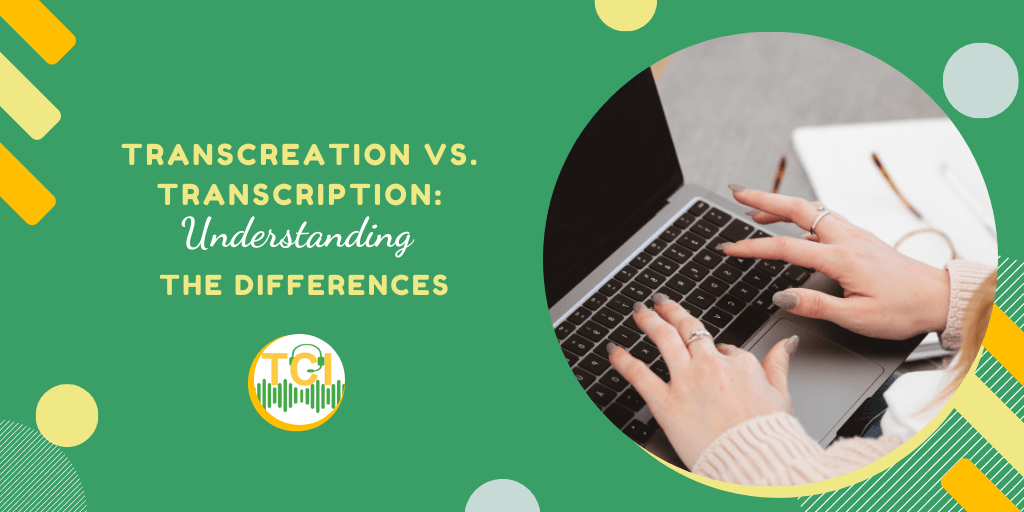
Language is a powerful tool that connects people and cultures. In an increasingly globalized world, the ability to communicate effectively across borders has become indispensable.
Businesses, individuals, and organizations constantly seek ways to break down language barriers to reach and engage wider audiences. Two important processes that facilitate this are transcreation and transcription.
While these terms may sound similar, they involve different linguistic approaches. In this article, we'll explore the nuances of transcreation and transcription and their respective roles in bridging language gaps.
Whether you're a business owner looking to expand your reach or a curious language enthusiast, understanding these differences can help you make informed decisions and create meaningful connections with your target audience.
Transcreation, a blend of "translation" and "creation," goes beyond the literal conversion of words from one language to another.
It involves adapting the content to resonate with a specific target audience's cultural nuances, beliefs, and preferences.
The objective is to recreate the emotional impact and intention of the original message in a new language and cultural context.
Imagine a global brand launching a marketing campaign in Singapore. While a word-for-word translation may capture the basic meaning of the original message, it may fail to connect with local consumers on a deeper level.
Transcreation, on the other hand, considers cultural references, idioms, humor, and even regional dialects, resulting in more persuasive and engaging communication that resonates with the target market.
For example, a multinational transcreation company launching a social media campaign to promote a new product to Singaporean millennials may use humor and pop culture references that are specific to the local context.
By leveraging transcreation, they can adapt their content to Singaporean sensibilities, making it more relatable and memorable to the target demographic.
Transcription, on the other hand, involves converting spoken language into written form. It is often used in various industries, such as legal, medical, and media, where accuracy and clarity of recorded information are paramount.
You can become a certified transcriptionist and earn a living from the comfort of your home! There are many online courses and certifications available to equip you with the skills and knowledge to excel in this in-demand field.
Transcription services are commonly employed to create subtitles for videos, transcribe interviews or focus group discussions, or convert audio recordings into text for further analysis or documentation.
For instance, a research team conducting interviews with Singaporean residents on their experiences during a pandemic may require transcription services to convert the recorded interviews into written text. This allows them to analyze the data more easily and draw meaningful insights from the responses.
Let's now explore different perspectives on transcreation and transcription, exploring how each process contributes to effective communication and localization.
From the branding perspective, transcreation takes center stage.
Transcreation becomes a critical tool for businesses looking to establish a strong brand identity in new markets.
A successful transcreation strategy allows them to convey the essence of their brand, tailoring it to resonate with the target audience's emotions, values, and cultural norms.
For example, IPPWORLD, a leading language solutions provider based in Singapore, emphasizes the significance of transcreation in helping businesses connect with their audiences across cultures.
Businesses can create a lasting emotional connection with their customers by adapting brand messages, slogans, and advertising campaigns to local contexts.
Transcription plays a crucial role in accurate information transfer. It ensures that spoken words are translated precisely into written form, enabling effective communication and documentation across various industries.
For instance, transcription services are essential for accurately documenting patient records and medical reports in the medical field. They also give healthcare providers a comprehensive overview of a patient's medical history and treatment plans.
Similarly, subtitles and closed captions are often added to videos and broadcasts in the media industry to make content accessible to a wider audience. Transcription services play a vital role in creating accurate and synchronized captions that enhance viewers' understanding and engagement.
While transcreation and transcription may be separate processes, there are cases where they intersect, blurring the lines between the two.
This intersection occurs when transcriptions involve translating content that reflects cultural nuances, humor, or regional dialects, requiring transcreation skills to ensure effective localization.
Consider a stand-up comedy performance recorded for an international audience, including Singaporean viewers.
The transcription process involves accurately capturing the comedian's words, but transcreation becomes necessary when translating jokes or cultural references that may not resonate the same way in different cultures.
In this case, the transcriber must deeply understand the cultural context and linguistic nuances to ensure accurate yet culturally adapted translations.
As a content creator who has worked with clients across industries and cultures, I have witnessed firsthand the power of transcreation and transcription.
One of my most memorable experiences was collaborating with a Singapore-based e-commerce company seeking to expand its market reach.
Understanding the need for transcreation, we adapted their product descriptions and marketing material to suit their target audience's cultural preferences and expectations.
On the other hand, I have also worked on transcription projects where my attention to detail and accuracy was paramount.
Transcribing interviews and focus group discussions required careful listening and precisely capturing every spoken word.
These experiences have given me a deeper appreciation for the role of transcriptions in ensuring effective communication and accurate documentation.
Transcreation and transcription are both crucial components of effective communication and localization.
While transcreation adapts content to resonate with a target audience's cultural nuances, transcription ensures accurate documentation and communication across various industries.
Understanding these differences is vital for businesses seeking to expand their markets and connect with their audiences. Viewing transcreation and transcription from different perspectives highlights their unique roles and contributions. From a branding standpoint, transcreation helps establish emotional connections and adapt content to resonate with different cultures.
In contrast, transcription focuses on accuracy and clarity in documentation and communication. However, it's important to note that these processes are not always mutually exclusive. There are instances where they intersect, blurring the lines between transcreation and transcription. This occurs when transcriptions involve translating content that requires cultural adaptation, such as humor or dialects.
Whether you're a business owner, a language enthusiast, or someone seeking effective communication, understanding the differences between transcreation and transcription empowers you to make informed decisions and connect with your audience meaningfully.
Can be better
Easy to read/ understand
Found it helpful

Your TRANSCRIPTION CAREER CAPSULE to Help You BOOST Your Potential
Latest Industry News, Jobs, Tips and More..

Comments are closed